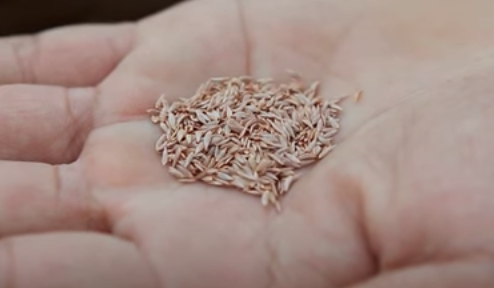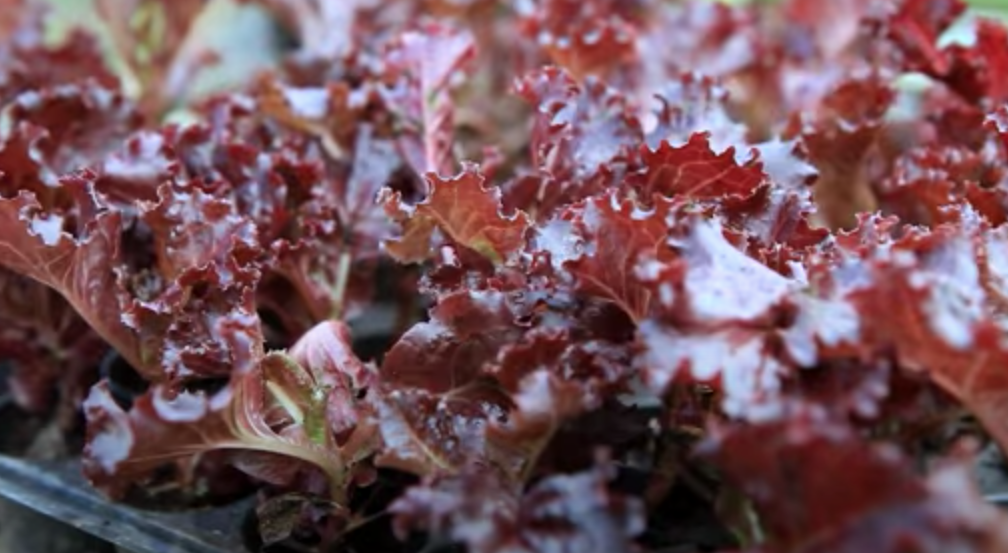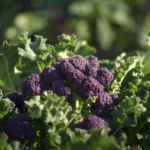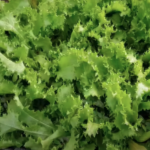Purple lettuce is a dietary leafy vegetable that has light purple to deep purple looking leaves. Purple lettuce is sometimes interchangeably referred to as red lettuce. The purple to red pigmentation in the leaves is due to a naturally occurring water-soluble bio-compound which itself confers some superior health benefits in humans. There are many purple lettuce varieties, a good number of these are hybrid cultivars. Purple loose leaf lettuce is primarily used raw in a variety of culinary recipe applications which include salads, sandwiches, burgers, stir-fries and juices.
Table of Contents
What is Purple Lettuce?
Purple Loose-leaf Lettuce Genus
Purple lettuce is a bonafide lettuce cultivar which shares with the more common green lettuce in the botanical name Lactuca sativa. Both these varieties belong to the Daisy family. As earlier stated, there are many lettuce varieties on the planet. Cornell University identifies five lettuce categories consisting of loose-leaf, butterhead, Romaine, French and crisphead lettuce. Each of these has numerous varieties within it.
Purple lettuce varieties are mostly associated with loose-leaf cultivars. They typically have broad, curly and frill looking leaves which do not form into a tight head. In some cultivars such as the Ruby, the purple/red color may be distributed more intensely to the margins of the leaves whilst the rest of the leaf down to the stalk maintains its green pigmentation. Yet some varieties such as the Red salad bowl lettuce, may have fully purple pigmented leaves with very little to no trace of green at all.
Why is purple loose-leaf lettuce purple?
The purple occurring in purple lettuces is conferred on the plant’s leaves by anthocyanins. According to the journal, Food and Nutrition Research, anthocyanins are water-soluble pigments which produce red, purple, and blue colors in fruits and vegetables. Examples of anthocyanin endowed foods include purple broccoli, purple basil blooms, beets, sweet peppers, red cabbage, purple tomatoes, purple eggplants and berries among other common fruits and vegetables.
Purple and red lettuces are often indistinguishable. This is to say when a recipe mentions purple lettuce, for example, it is essentially referring to red lettuce and vice versa. Furthermore, some commercial outlets sell purple lettuce as red lettuce and contrariwise. The level of anthocyanins in the lettuce leaves ultimately determines the color and appearance of the lettuce leaves.
According to the Food and Nutrition Research journal, the color and stability of the pigments in different fruits and vegetables is subject to certain important factors such as pH, light, temperature, and structure.
Furthermore, the journal states that acidic conditions cause anthocyanins to give a red pigmentation which changes to blue when pH increases. Changes in pH seem to slide the color of the fruit or vegetable up or down the red, blue or purple hue spectrum. Purple lettuce hue is thus according to interactions between anthocyanins and the earlier mentioned factors some of which are environmental factors.
Why purple loose-leaf lettuce must be colorful
Thus far, it seems the answer to why purple lettuce is purple appears to have been limited to complex bio-chemical processes that occur behind the scenes. There is, however, a less complicated biological reason why plants such as lettuce would need to be this colorful.
According to the Journal of Biomedicine and Biotechnology, pigments such as purple in purple lettuce are useful to the plant in managing environmental stress ranging from drought, UV light and heavy metals. This, in fact, has been cited elsewhere as one of the reasons purple broccoli can overwinter unlike the regular green broccoli.
Apparently, in the process of this complex plant biological design, purple loose-leaf lettuce and such other deep colored fruits and vegetables unwittingly avail important benefits to human dietary needs.
Purple Lettuce Benefits
Apart from being an attractive and curiosity raising vegetable in the midst of other fresh produce, purple lettuce offers some worthier health benefits in comparison to regular green lettuce, for example. Purple loose-leaf lettuce is considered among what have since been termed functional foods thanks to the present antioxidant flavonoids. According to Colorado State University Extension, functional foods are foods which have much more to offer than just basic nutrition.
Antioxidant anthocyanins found in purple lettuce bring to the table desirable health benefits which go beyond regular nutrition. According to the journal Phytochemistry, anthocyanins play a protective role against a wide range of diseases which include certain cancers and some human metabolic problems.
The actual mechanism by which antioxidants work in the human body is through the prevention and repair of cell damage caused by free radicals. The human body is perpetually interacting with free radicals generated internally and externally. These cause cell damage which in turn results in inflammation and development of diseases such as some cancers.
For many interested in public health, purple lettuce is well positioned to make a consequential impact in the general population considering that lettuce is one of the most consumed leafy greens in the United States and globally, in general.
While all lettuce crops regardless of color have some nutrients such as Vitamins K, A, B and C. According to the journal Antioxidants, eating purple or blue fresh produce such as purple lettuce has been linked to increased nutrient intake in humans and a lowered risk of metabolic syndrome.
Summarized, the following are some superior human health benefits associated with the consumption of antioxidant rich fresh produce, in the mould of purple lettuce, be it fruits or vegetables.
- Blood pressure management
- Cancer treatment and prevention
- Anti-inflammatory benefits
- Liver damage protection
- Vision improvement
- Antimicrobial benefits
- Heart disease protection
Purple Lettuce Recipes
Purple loose-leaf lettuce is primarily used raw in different recipe preparations. One of the most common applications is salad mixes, sandwiches, burgers and wraps. As a matter of fact, purple lettuce can easily be used as a substitute to/or in combination with green lettuce. It brings aesthetically pleasing color to recipe preparations.
The following is a scrumptious recipe collection that utilizes purple lettuce.
| Purple Lettuce Salad Recipe with Tomato and Cucumber – this recipe is open to all kinds of lettuces. You are free to combine different ones or just stick with purple loose-leaf lettuce. The final results will be equally delicious and pleasing. Other ingredients will be cucumber, herbs, tomato and some spices. Pertaining to cucumber, there is also a choice to use English cucumber, Persian cucumber, Lemon cucumber or Armenian cucumber all of which can be perfect matches because they are burpless cucumbers with edible skin. The recipe will take 15 minutes to make. For best results, we highly recommend using a spinner to wash and dry your purple lettuce leaves properly (see more about spinners below). View Recipe. |
| Salmon and Red Oak Leaf Salad Recipe – this is a simple 10 minute salad recipe with a scrumptiously promising outcome. The main ingredients will be a full purple loose-leaf lettuce, some smoked salmon, thinly sliced apple, zucchini, apple cider vinegar, mayonnaise and mustard among other ingredient items. Your apple and zucchini ingredients will require some very thin slicing. For this, we recommend a mandoline. Your lettuce will be washed and dried first. If you are not using a spinner, simply pat dry the lettuce leaves with a kitchen paper towel. View Recipe. |
| Peach and Oak Leaf Lettuce Salad Recipe – if you enjoy a quick and easy salad recipe, this would be yet another one. In just 10 minutes you will have a variation to the forgoing recipe which also utilizes oak leaf lettuce. This recipe will be in two parts – the salad and then the vinaigrette dressing. For the salad some purple lettuce will be required along with some peaches, goat cheese and walnuts. The dressing has a few items on it which include white balsamic vinegar, honey and extra virgin oil among other ingredients. Again, the lettuce must be washed and dried before use. The lettuce spinner does the job well here ensuring the dressing properly adheres to the salad after all the water has been thoroughly removed. View Recipe. |
| Stir-Fried Purple Lettuce Recipe – thus far we have considered lettuce salad recipes. This is one of the few recipes where lettuce is actually cooked vs using it raw. Although the recipe calls for iceberg lettuce, you are free to use any purple lettuce variety or in combination with iceberg lettuce itself. Other ingredients to go in are Chinese rice wine, soy sauce, vegetable oil, fresh ginger and pepper flakes among other items. This recipe takes only 15 minutes to make and serves 4. View Recipe. |
| Bitters Juice Recipe – finally, we earlier mentioned that raw purple lettuce is also used in juices. This juice recipe is an example of raw lettuce used in making juices. This juice is a reboot juice designed to be bitter so as to stimulate digestive enzymes which are said to be useful for digestion and bile production. Although the recipe calls for radicchio lettuce, red or purple lettuce can be used as a substitute. This recipe produces about 18 oz or 500 ml in juice. This volume can be increased by doubling the ingredients, for example. View Recipe. |
Purple Lettuce Seeds

Purple lettuce seeds are easily accessible and can be ordered online from a variety of seed sources. As earlier mentioned, these seeds are available as heirloom open-pollinated seeds or hybrid varieties.
If the seeds are not chemically treated, they can also be used to grow lettuce microgreens which are highly nutritious produce harvested only a few days after germination.
If you plan to let your lettuce go to seed for the purposes of saving purple lettuce seed, the advice is only use open pollinated varieties for seed saving. Hybrid varieties produce very poor seed or simply produce seed that fails. The poor and undesirable traits that had been suppressed in the F1 seeds, tend to come back in the second generation of the plants. This is one of the reasons only open pollinated seeds are used for seed saving.
The following is a list of purple loose-leaf lettuce seed suppliers in North America.
- Ruby Loose-Leaf Lettuce Seeds via Amazon
- Bowl Lettuce Seeds via Amazon
- Pine Tree Garden Seeds Purple Lettuce
- Purple Loose-leaf lettuce Seeds from West Coast Seeds
- Lollo Rossa Lettuce Seeds from Baker Creek
- Merlot Purple Loose-leaf Lettuce Seeds from Baker Creek
- Burgundy Delight Lettuce Seeds from Burpee
- Cimmaron Lettuce Seeds from Burpee
Growing Purple Loose-leaf Lettuce
Growing purple loose-leaf lettuce is, for the most part, similar to growing approaches of a variety of other green loose-leaf lettuces. This makes purple lettuce just as simple and easy to grow in the home garden as its green counterparts.
Lettuce can be directly propagated from seed into the soil or planted as transplants. If you can find the right variety, transplants from the local nursery, for example, have the advantage of gaining time in the season
The fundamentals to growing purple lettuce are similar to other lettuces. Cool weather is essential. This also extends to seed sowing. When the temperatures are too high, the seeds tend to remain dormant, prolonging germination time. According to Cornell University, best germination is realized at 70 F or 21°C. Temperatures that are too high can also affect the germination rate of the lettuce. To better manage the temperatures, purple lettuce is ideally planted early spring and/or late summer.
Purple loose-leaf lettuce also does well in containers. The containers can be as small as 8 inches or 20 cm in diameter. The primary consideration is for the container to have drainage holes to dump excess water after watering. Whether its container or ground, lettuce does well in loose cool soils that are nutrient rich. Soil richness can be achieved through adding compost or manure to the growing medium.
Although simple, there is more to appreciate about growing purple lettuce such as general care which includes watering, thinning and weed control, harvesting, pests and diseases. We thus recommend this detailed general guide by the University of Minnesota on Growing Lettuce.
Conclusion
Purple lettuce is a leafy green vegetable in the lettuce family that has purple looking leaves. This type of lettuce is often interchangably referred to as red leaf lettuce. The purple in the leaves is biologically useful to the plant for its own existence and is conferred by a specific naturally occurring water-soluble compound.
Depending on other present factors in and around the lettuce plant itself, the lettuce plant turns out with a certain pigmentation intensity. Antioxidants in purple lettuce have superior health benefits which have led to the lettuce being considered among trendy functional foods. This lettuce is mainly used raw in a variety of recipes. Purple loose-leaf is easy to grow following the same growing culture as green lettuce. This is one of the reasons it is popular with home growers.
Random But Good Reads:


